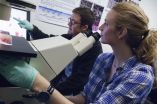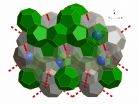(Press-News.org) CAMBRIDGE, MA, December 10, 2014 - A team of investigators from the Broad Institute, Massachusetts General Hospital and other leading biomedical research institutions has pinpointed rare mutations in a gene called APOA5 that increase a person's risk of having a heart attack early in life. These mutations disable the APOA5 gene and also raise the levels in the blood of triglyceride-rich lipoproteins, a type of fat. The researchers' findings, together with other recent genetic discoveries -- specifically, the identification of protective mutations in the APOC3 gene that lower triglyceride levels and the risk of heart attack -- refocus attention on abnormal triglyceride metabolism as an important risk factor for heart attack at any age. The work -- the largest exome sequencing study yet published for any disease -- appears this week in the journal Nature.
"Our APOA5 result tells us that beyond LDL levels, which are well known to contribute to heart attack risk, abnormalities in triglyceride metabolism also play an important role," said Sekar Kathiresan, a senior author of the study, Broad associate member, and director of preventive cardiology at Massachusetts General Hospital.
"This gives us an important window into the biology of the disease and also suggests potential new avenues for therapeutic development."
There are some striking parallels between Kathiresan's work and a similar study conducted over 40 years ago and published in 1973. That historic effort, which was led by Joseph Goldstein and his colleagues, examined several hundred people from Seattle, Washington who had suffered a heart attack before age 60. Looking at the levels of lipids in the blood, Goldstein and his team identified high total cholesterol levels as the major abnormality associated with early-onset heart attack. That work spurred decades of research trying to unravel the role of LDL, the major carrier of cholesterol in the bloodstream, in causing atherosclerosis -- the progressive accumulation of fatty material in blood vessel walls that can lead to a heart attack. It also led to a Nobel Prize for Goldstein and his colleague Michael Brown. Interestingly, in the seminal work from 1973, the second most common abnormality observed by Goldstein and his colleagues was elevated blood triglycerides.
In addition to underscoring the role of high triglycerides in heart attack risk, Kathiresan and his colleagues also found that harmful LDL receptor mutations are more prevalent than previously believed -- roughly twice as common than had been estimated in the Goldstein study.
"In 1973, Goldstein's work taught us what types of lipids in the blood are most important for early heart attack risk," said Kathiresan. "Now, after sequencing all of the genes in the genome, we can directly point to the specific genes that are most important. There is remarkable consistency between the observations from 40 years ago and today."
Heart attacks are extremely common. In the United States, someone suffers from one roughly every 34 seconds. Even though the condition is widespread, it tends to strike later in life. Only about 5 percent of people who suffer a heart attack do so at a relatively young age -- before age 50 for men and before age 60 for women. Tragically, the first sign of illness in this minority is often a devastating heart attack, inflicting significant damage to the heart and resulting in severe disability, even death.
Kathiresan has had a long-standing interest in the genetics of early-onset heart attack. In his current work, he and his colleagues conducted a large-scale, DNA sequencing-based study, focusing exclusively on the protein-coding portion of the genome, called the exome. They analyzed the exomes of roughly 10,000 people -- half of whom had suffered from an early heart attack and half who had not.
Using this exome-based approach, the researchers zeroed in on two genes, LDLR and APOA5. Their findings implicating a role for multiple rare mutations in the LDL receptor gene (LDLR) in early heart attack confirms what is already well-known from decades of research: that high levels of LDL, the so-called "bad" cholesterol, is a key risk factor that raises the risk of heart attack. The second major finding -- evidence linking rare mutations in the APOA5 gene, encoding an apolipoprotein, and early heart attack -- highlights the role of triglyceride levels in heart attack. Kathiresan and his colleagues discovered that people carrying APOA5 mutations have higher levels of blood triglycerides and a roughly two-fold increased risk of a heart attack.
Although APOA5 had been previously implicated in the condition, it required the resolution of large-scale DNA sequencing to definitively make the connection between APOA5 and heart attack risk.
"We simply wouldn't have made this critical connection without our careful and disciplined approach to whole exome sequencing and subsequent data analysis," said Stacey Gabriel, a co-author of the Nature study and director of the Broad Institute's Genomics Platform.
This work points to several features being key to successful sequencing studies focused on finding rare variations (or "variants") in the genome. These include the importance of large sample sizes to help distinguish harmful from benign genetic variants (typically thousands of cases and controls), as well as precise statistical analyses, including so-called "aggregation tests" that enable the combined analysis of multiple distinct rare variants within the same gene.
Together with his recent discovery of another apolipoprotein gene, APOC3, that also influences triglyceride levels and heart disease, Kathiresan's findings point to an important role for triglycerides in influencing heart attack risk -- something that had been largely disregarded until recently. In addition to casting new light on disease biology, the work also suggests a potential path for future therapeutic development in heart disease.
INFORMATION:
The study was supported by the National Heart, Lung, and Blood Institute (NHLBI) and the National Human Genome Research Institute (NHGRI) of the U.S. National Institutes of Health (NIH); The Massachusetts General Hospital (MGH), the Howard Goodman Fellowship from MGH; the Donovan Family Foundation; Fondation Leducq; Canadian Institutes of Health Research; RFPS.
About the Broad Institute of MIT and Harvard
The Eli and Edythe L. Broad Institute of MIT and Harvard was launched in 2004 to empower this generation of creative scientists to transform medicine. The Broad Institute seeks to describe all the molecular components of life and their connections; discover the molecular basis of major human diseases; develop effective new approaches to diagnostics and therapeutics; and disseminate discoveries, tools, methods, and data openly to the entire scientific community.
Founded by MIT, Harvard, and its affiliated hospitals, and the visionary Los Angeles philanthropists Eli and Edythe L. Broad, the Broad Institute includes faculty, professional staff, and students from throughout the MIT and Harvard biomedical research communities and beyond, with collaborations spanning over a hundred private and public institutions in more than 40 countries worldwide. For further information about the Broad Institute, go to http://www.broadinstitute.org.
Paper cited:
Do, R et al. Exome sequencing identifies rare LDLR and APOA5 alleles conferring risk for myocardial infarction. Nature. Online First: December 10, 2014. DOI:10.1038/nature13917
Stem cells in early embryos have unlimited potential; they can become any type of cell, and researchers hope to one day harness this rejuvenating power to heal disease and injury. To do so, they must, among other things, figure out how to reliably arrest stem cells in a Peter Pan-like state of indefinite youth and potential. It's clear the right environment can help accomplish this, acting as a sort of Neverland for stem cells. Only now are scientists beginning to understand how.
New collaborative research between scientists at Rockefeller University and Memorial ...
The dragonfly is a swift and efficient hunter. Once it spots its prey, it takes about half a second to swoop beneath an unsuspecting insect and snatch it from the air. Scientists at the Howard Hughes Medical Institute's Janelia Research Campus have used motion-capture techniques to track the details of that chase, and found that a dragonfly's movement is guided by internal models of its own body and the anticipated movement of its prey. Similar internal models are used to guide behavior in humans.
"This highlights the role that internal models play in letting these creatures ...
INDIANAPOLIS -- How do some proteins survive the extreme heat generated when they catalyze reactions that can happen as many as a million times per second? Work by researchers from Indiana University-Purdue University Indianapolis (IUPUI) and the University of California Berkeley published online on Dec. 10 in Nature provides an explosive answer to this important question.
Proteins are essential to the human body, doing the bulk of the work within cells. Proteins are large molecules responsible for the structure, function, and regulation of tissues and organs. Enzymes ...
CORVALLIS, Ore. - Nitrous oxide (N2O) is an important greenhouse gas that doesn't receive as much notoriety as carbon dioxide or methane, but a new study confirms that atmospheric levels of N2O rose significantly as the Earth came out of the last ice age and addresses the cause.
An international team of scientists analyzed air extracted from bubbles enclosed in ancient polar ice from Taylor Glacier in Antarctica, allowing for the reconstruction of the past atmospheric composition. The analysis documented a 30 percent increase in atmospheric nitrous oxide concentrations ...
In a ground-breaking paper published in Nature, they show that the three protein complexes act in relay to regulate cell division: reactivation of one leads to the second becoming active.
Cells rely on control systems to make sure that each aspect of the cell division cycle occurs in the correct order. Following successful segregation of the genomes in mitosis, each must return to its pre-division state in a process called mitotic exit. Mitotic exit is irreversible for all multicellular organisms. Loss of cell cycle control during this process - leading to unregulated ...
Clathrates are now known to store enormous quantities of methane and other gases in the permafrost as well as in vast sediment layers hundreds of metres deep at the bottom of the ocean floor. Their potential decomposition could therefore have significant consequences for our planet, making an improved understanding of their properties a key priority.
In a paper published in Nature this week, scientists from the University of Göttingen and the Institut Laue Langevin (ILL) report on the first empty clathrate of this type, consisting of a framework of water molecules ...
CAMBRIDGE, MA -- Using a gene-editing system originally developed to delete specific genes, MIT researchers have now shown that they can reliably turn on any gene of their choosing in living cells.
This new application for the CRISPR/Cas9 gene-editing system should allow scientists to more easily determine the function of individual genes, according to Feng Zhang, the W.M. Keck Career Development Professor in Biomedical Engineering in MIT's Departments of Brain and Cognitive Sciences and Biological Engineering, and a member of the Broad Institute and MIT's McGovern Institute ...
Anticipated changes in climate will push West Coast marine species from sharks to salmon northward an average of 30 kilometers per decade, shaking up fish communities and shifting fishing grounds, according to a new study published in Progress in Oceanography.
The study suggests that shifting species will likely move into the habitats of other marine life to the north, especially in the Gulf of Alaska and Bering Sea. Some will simultaneously disappear from areas at the southern end of their ranges, especially off Oregon and California.
"As the climate warms, the species ...
For the firefighters and rescue workers conducting the rescue and cleanup operations at Ground Zero from September 2001 to May 2002, exposure to hazardous airborne particles led to a disturbing "WTC cough" -- obstructed airways and inflammatory bronchial hyperactivity -- and acute inflammation of the lungs. At the time, bronchoscopy, the insertion of a fiber optic bronchoscope into the lung, was the only way to obtain lung samples. But this method is highly invasive and impractical for screening large populations.
That motivated Prof. Elizabeth Fireman of Tel Aviv University's ...
There are pros and cons to the support that victimized teenagers get from their friends. Depending on the type of aggression they are exposed to, such support may reduce youth's risk for depressive symptoms. On the other hand, it may make some young people follow the delinquent example of their friends, says a team of researchers from the University of Kansas in the US, led by John Cooley. Their findings are published in Springer's Journal of Psychopathology and Behavioral Assessment.
Adolescence is an important time during which youth establish their social identity. ...





